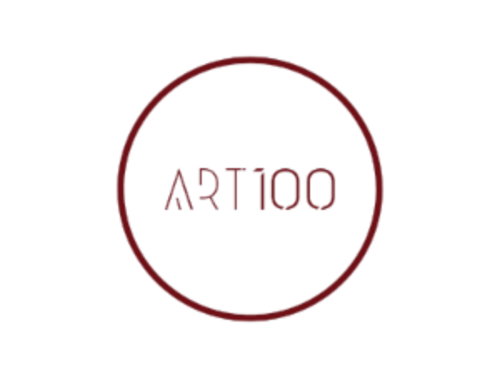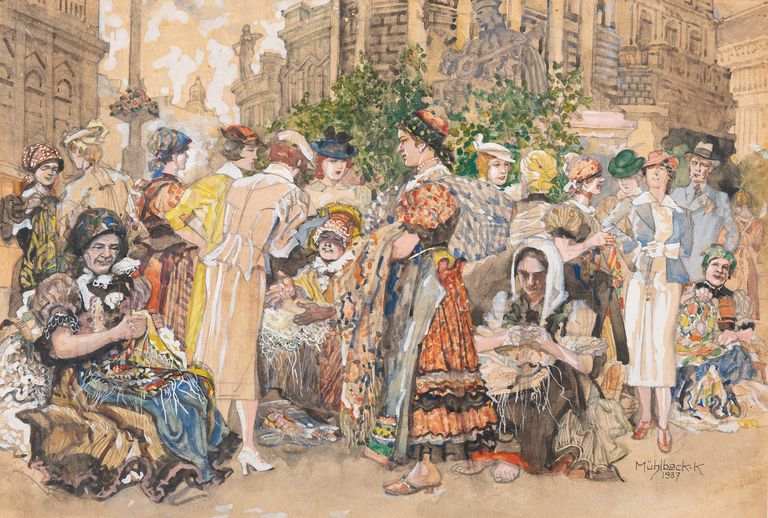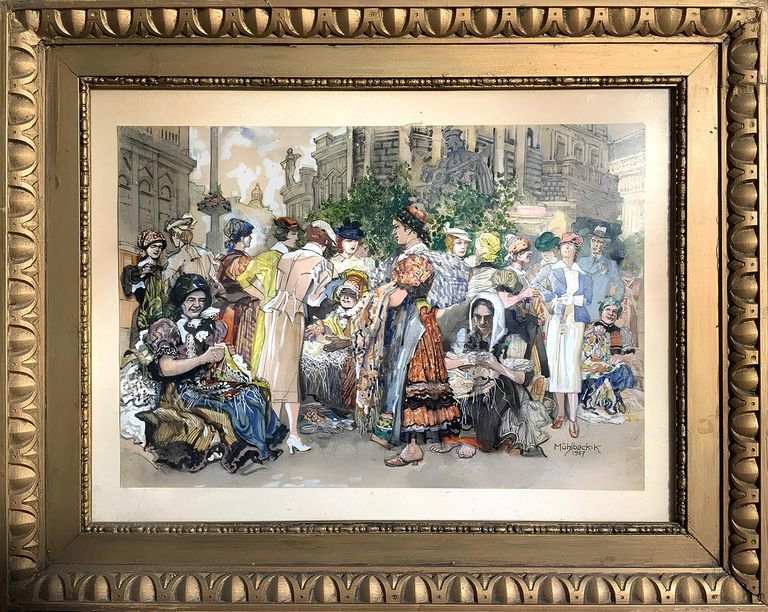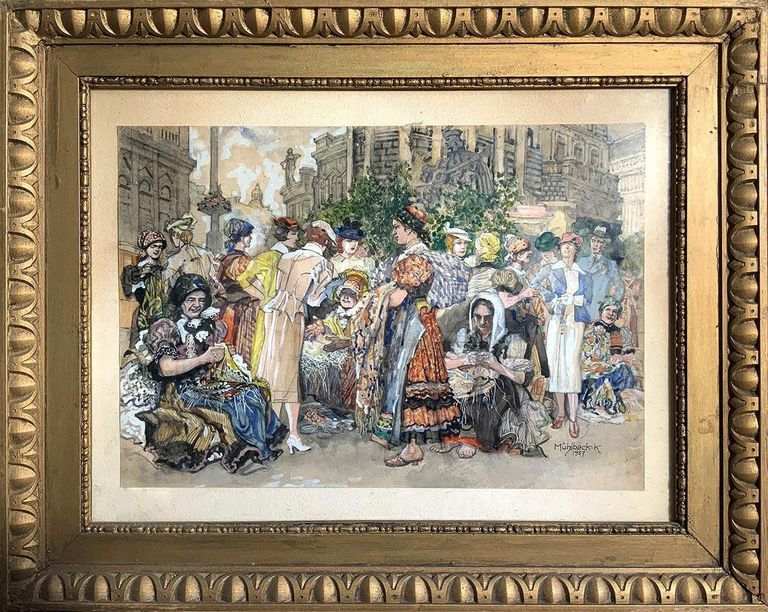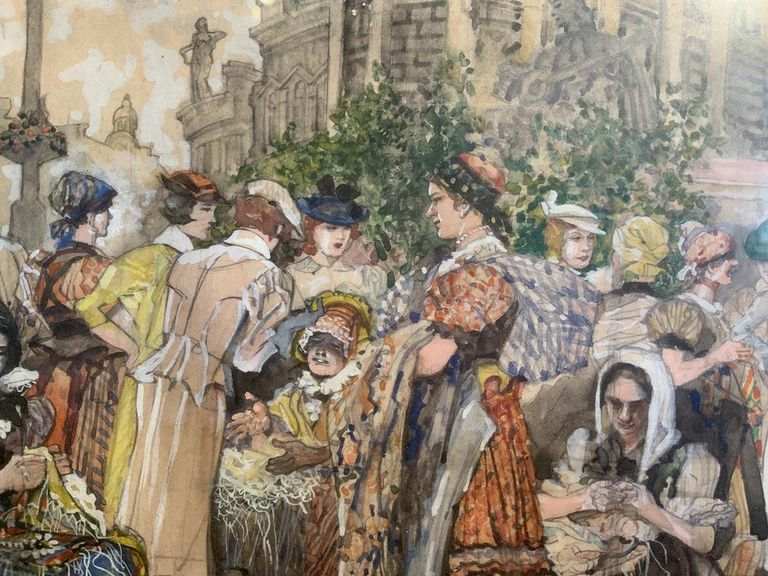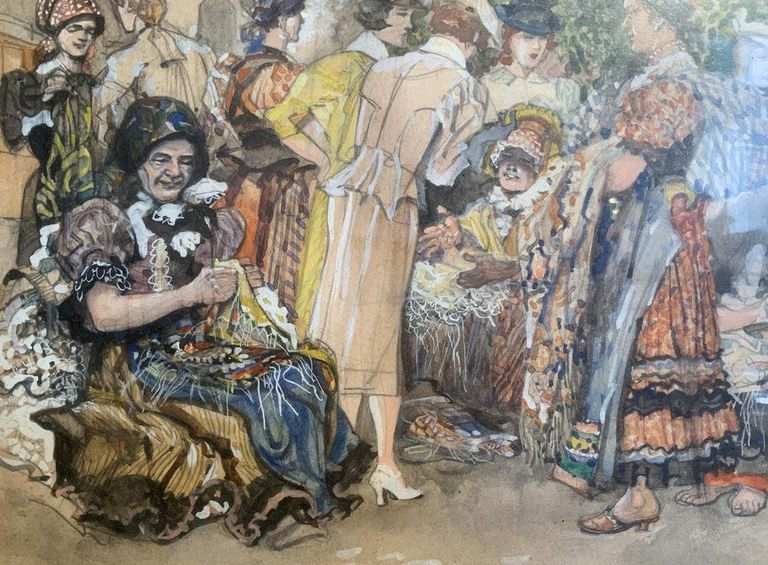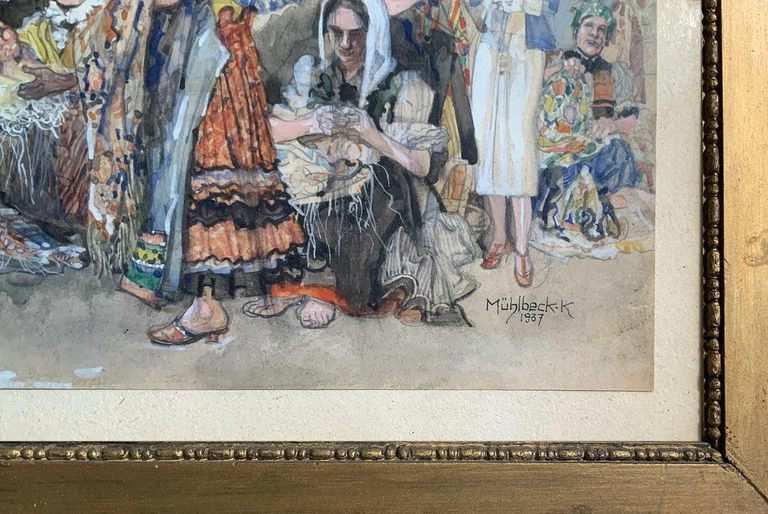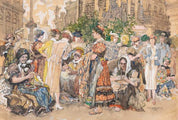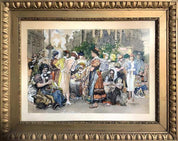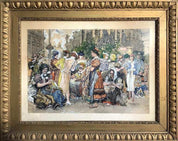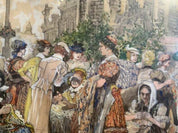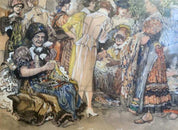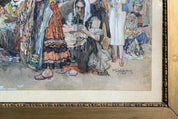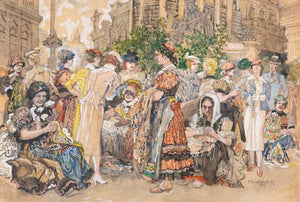Similar Items
Karoly Muhlbeck Weavers at The Market
$800.00 USD
Artist: Károly Mühlbeck (1869-1943)
Title: Weavers of Market
Medium: Gouache
Signature: Signed and dated "Mühlbeck k-1937"+ Description: Step into the vibrant world of Károly Mühlbeck's "Weavers of Market," a gouache painting that captures the essence of bustling market scenes. With a masterful use of color and texture, Mühlbeck transports you to a lively market where weavers engage in their craft.
The artist's signature in the bottom corner, "Mühlbeck k-1937," is a testament to his creative vision and commitment to his art. The careful attention to detail in each brushstroke reveals the weavers' intricate work and the vibrant tapestry of the market environment.
Measuring unframed, this painting allows you to appreciate Mühlbeck's artistic technique up close. The gouache medium adds depth and richness to the scene, creating a sense of immediacy and connection with the subject.
"Weavers of Market" by Károly Mühlbeck invites you to immerse yourself in the world of skilled artisans and bustling markets, capturing a moment in time that resonates with both artistic beauty and cultural significance.
Károly Mühlbeck was a painter, graphic artist and caricaturist, who spent most of his life in Hungary. He made cartoons, both single panel or sequential, for a great many magazines, but he was mostly associated with Borsszem Jankó and Új Idők. For the latter, he made his famous "Mühlbeck headlines", in which he commented on the news of the day.
Early life and career
Károly Mühlbeck (also written as Károly Mülbeck) was born in 1869 in Šurany, a town in southern Slovakia. He started drawing at the age of five, but originally had the childhood desire to become either a shepherd or a soldier. These ambitions didn't come to fruition, but the two professions were prominently represented in his paintings in later years. Mühlbeck attended elementary and grammar school in Bratislava, where he also picked up German, as it was the common language in the educational system. He eventually went to Budapest to study at the Hungarian Royal Drawing School, with the intention of becoming a teacher. He graduated in 1891, but in the end didn't find his calling in teaching.
Early cartooning work
Among his earliest assignments were book illustrations for the publisher Singer and Wolfner in the early 1890s. In 1892, his first cartoons and comic strips appeared in Kakas Márton, the bi-weekly supplement of the Hungarian newspaper Budapesti HÃrlap. His contributions commented on the news events of the day from the newspaper's conservative viewpoint. Afterwards he began his long association with Borsszem Jankó, one of Budapest's prime political magazines, aimed at the conservative urban bourgeoisie. Mühlbeck contributed cartoons and sequential pieces between 1906 and 1925.
Mühlbeck headlines
From 1903 until his death in 1943 he was present in the rural intellectual weekly Új Idők ("New Times") with his so-called "Mühlbeck headlines". In this special format, Mühlbeck presented a short news item in one single line, and then commented on it in one or more panels. In the image the cartoonist either showed the reactions of different types of people to the news, or what the consequences of the headline could be. The headlines were single panel cartoons most of the time, but sometimes also presented a linear story. They were also collected in book collections under the title 'Mühlbeck Károly Vidám Fejlécei' ("Károly Mühlbeck's Funny Headlines"), with a preface writen Új Idők's editor, the author and triple Nobel Prize nominee Ferenc Herczeg.
Other works
In addition to the aforementioned titles, Mühlbeck worked as either illustrator or picture story author for Borsszem Jankó Naptár (1911-1915), SzÃnházi Élet (1916-1919), Ludwig Baka (1917), Magyar Lányok (1918–1940), Mátyás Diák (1919), A Dugó (1919), Ifj. Borsszem Jankó (1920), Képes Krónika (1923), Nimród (1923), Ország-Világ (1925), Levente (1928-1930), Szent György (1924), Rádió Élet (1930-1933), Nemzeti Sport (1930), Új IdÅ‘k (1930), TündérVásár (1931-1942) and Muskátli (1937). He was also the author and illustrator of the children's story collection 'Mühlbeck bácsi képes gyerekkönyve' ("Uncle Mühlbeck's Picture Book"). This was followed posthumously by 'Nagymama képeskönyve' ("Grandma's Illustrated Book", 1985).
llustrator
Throughout his career, Mühlbeck illustrated almost 400 books, most of which aimed at children. Among the many prominent writers whose work he provided with drawings are Gyula Krúdy, Géza Gárdonyi, Ernő Szép, Ferenc Herczeg and Lajos Pósa. He was the illustrator of Zsigmond Sebők's fairy tale series 'Mackó úr utazásai' ('Mr. Teddy Bear's Travels'), which originally appeared in the children's magazine Az Én Újságom from 1889 on and then in books from 1902 on. In 1909 the character found a new home in the children's magazine Jó Pajtás under the name 'Dörmögő Dömötör'. After the death of the original author in 1916 the anthropomorphic bear disappeared. He was however revived by other authors and illustrators in its own magazine, which has appeared in Hungary ever since 1957.
Paintings
Károly Mühlbeck was furthermore active as a watercolor painter, mostly inspired by Hungarian folk life. Soldiers, foals, shepherds and maidens in love were recurring elements in his work, which was also characterized by the artist's knowledge of folk costumes, tools, weaponry and rural landscapes. His works are in the collections of the Hungarian National Gallery and the Petőfi Literary Museum in Budapest.
Death
Károly Mühlbeck passed away in 1943 at the age of 73, in Budapest's suburban Sashalom district.
Title: Weavers of Market
Medium: Gouache
Signature: Signed and dated "Mühlbeck k-1937"+ Description: Step into the vibrant world of Károly Mühlbeck's "Weavers of Market," a gouache painting that captures the essence of bustling market scenes. With a masterful use of color and texture, Mühlbeck transports you to a lively market where weavers engage in their craft.
The artist's signature in the bottom corner, "Mühlbeck k-1937," is a testament to his creative vision and commitment to his art. The careful attention to detail in each brushstroke reveals the weavers' intricate work and the vibrant tapestry of the market environment.
Measuring unframed, this painting allows you to appreciate Mühlbeck's artistic technique up close. The gouache medium adds depth and richness to the scene, creating a sense of immediacy and connection with the subject.
"Weavers of Market" by Károly Mühlbeck invites you to immerse yourself in the world of skilled artisans and bustling markets, capturing a moment in time that resonates with both artistic beauty and cultural significance.
Károly Mühlbeck was a painter, graphic artist and caricaturist, who spent most of his life in Hungary. He made cartoons, both single panel or sequential, for a great many magazines, but he was mostly associated with Borsszem Jankó and Új Idők. For the latter, he made his famous "Mühlbeck headlines", in which he commented on the news of the day.
Early life and career
Károly Mühlbeck (also written as Károly Mülbeck) was born in 1869 in Šurany, a town in southern Slovakia. He started drawing at the age of five, but originally had the childhood desire to become either a shepherd or a soldier. These ambitions didn't come to fruition, but the two professions were prominently represented in his paintings in later years. Mühlbeck attended elementary and grammar school in Bratislava, where he also picked up German, as it was the common language in the educational system. He eventually went to Budapest to study at the Hungarian Royal Drawing School, with the intention of becoming a teacher. He graduated in 1891, but in the end didn't find his calling in teaching.
Early cartooning work
Among his earliest assignments were book illustrations for the publisher Singer and Wolfner in the early 1890s. In 1892, his first cartoons and comic strips appeared in Kakas Márton, the bi-weekly supplement of the Hungarian newspaper Budapesti HÃrlap. His contributions commented on the news events of the day from the newspaper's conservative viewpoint. Afterwards he began his long association with Borsszem Jankó, one of Budapest's prime political magazines, aimed at the conservative urban bourgeoisie. Mühlbeck contributed cartoons and sequential pieces between 1906 and 1925.
Mühlbeck headlines
From 1903 until his death in 1943 he was present in the rural intellectual weekly Új Idők ("New Times") with his so-called "Mühlbeck headlines". In this special format, Mühlbeck presented a short news item in one single line, and then commented on it in one or more panels. In the image the cartoonist either showed the reactions of different types of people to the news, or what the consequences of the headline could be. The headlines were single panel cartoons most of the time, but sometimes also presented a linear story. They were also collected in book collections under the title 'Mühlbeck Károly Vidám Fejlécei' ("Károly Mühlbeck's Funny Headlines"), with a preface writen Új Idők's editor, the author and triple Nobel Prize nominee Ferenc Herczeg.
Other works
In addition to the aforementioned titles, Mühlbeck worked as either illustrator or picture story author for Borsszem Jankó Naptár (1911-1915), SzÃnházi Élet (1916-1919), Ludwig Baka (1917), Magyar Lányok (1918–1940), Mátyás Diák (1919), A Dugó (1919), Ifj. Borsszem Jankó (1920), Képes Krónika (1923), Nimród (1923), Ország-Világ (1925), Levente (1928-1930), Szent György (1924), Rádió Élet (1930-1933), Nemzeti Sport (1930), Új IdÅ‘k (1930), TündérVásár (1931-1942) and Muskátli (1937). He was also the author and illustrator of the children's story collection 'Mühlbeck bácsi képes gyerekkönyve' ("Uncle Mühlbeck's Picture Book"). This was followed posthumously by 'Nagymama képeskönyve' ("Grandma's Illustrated Book", 1985).
llustrator
Throughout his career, Mühlbeck illustrated almost 400 books, most of which aimed at children. Among the many prominent writers whose work he provided with drawings are Gyula Krúdy, Géza Gárdonyi, Ernő Szép, Ferenc Herczeg and Lajos Pósa. He was the illustrator of Zsigmond Sebők's fairy tale series 'Mackó úr utazásai' ('Mr. Teddy Bear's Travels'), which originally appeared in the children's magazine Az Én Újságom from 1889 on and then in books from 1902 on. In 1909 the character found a new home in the children's magazine Jó Pajtás under the name 'Dörmögő Dömötör'. After the death of the original author in 1916 the anthropomorphic bear disappeared. He was however revived by other authors and illustrators in its own magazine, which has appeared in Hungary ever since 1957.
Paintings
Károly Mühlbeck was furthermore active as a watercolor painter, mostly inspired by Hungarian folk life. Soldiers, foals, shepherds and maidens in love were recurring elements in his work, which was also characterized by the artist's knowledge of folk costumes, tools, weaponry and rural landscapes. His works are in the collections of the Hungarian National Gallery and the Petőfi Literary Museum in Budapest.
Death
Károly Mühlbeck passed away in 1943 at the age of 73, in Budapest's suburban Sashalom district.
Popular Items
